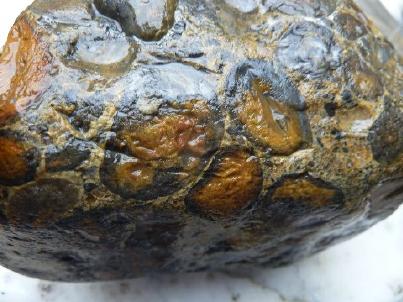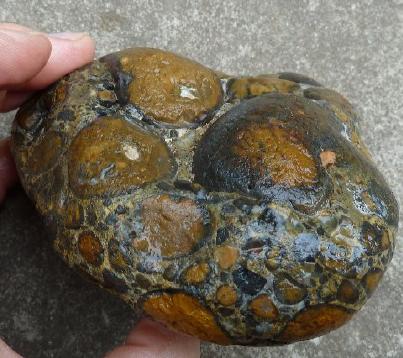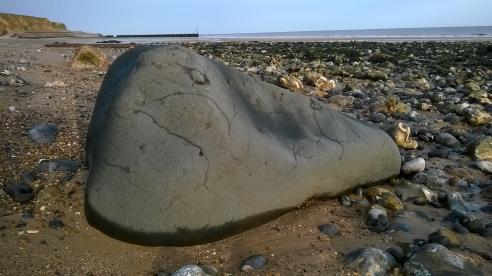Field Guide to the Deep History Coast
Erratics and stones on the beach
The beach materials come from three main sources:
- erosion of the cliff and foreshore,
- washed ashore by storms and tides from the North Sea bed and
- carried along the coast by longshore drift.
Of the material derived by erosion, some such as the Chalk and flint is autochthonous, that is, of local origin. Other material is allochthonous, or brought here from elsewhere by geological processes. The most obvious means of non-local material coming to Norfolk is by ice-transport during the Anglian glaciation, derived from northern Britain by sea ice and also Scandinavia (perhaps indirectly) and also by ice flowing eastwards into Norfolk from the East Midlands. But there was another input to the North Sea basin in pre-glacial times by river systems that were later obliterated by glaciation. The early River Thames flowed into this area bringing materials from the south Midlands and Southeast of England, while the extinct Bytham River flowed eastwards from the Midlands across the present position of the Wash and across Norfolk to join with the Thames and discharge into a common estuary and create a sedimentary fan in the North Sea basin. There may also be input from unknown river systems that had a north-westerly source.
The majority of these images are kindly supplied by Russell Yeomans, others by Martin Warren..
Hard crystalline rocks
Granite
Gneiss
Foliated gneiss. |
Granitoid. |
Gneiss country rock is cut by an acidic dyke. |
Still embedded in till. |
Schist
Gabbro and Dolerite
Ophitic gabbro. |
Dolerite |
Larvikite and rhomb porphyry and other porphyries
True rhomb porphyry is a lava containing conspicuous rhombic ('diamond') shaped phenocrysts. It is only found in three rift areas - Mount Kilimanjaro in north-eastern Tanzania; Mount Erebus in Antarctica and in the Oslofjord in southern Norway. It is derived from magma which when cooled in deep-seated plutons is a coarse-grained intermediate rock called larvikite. It has often been quoted as evidence for Scandinavian ice reaching Britain but this is disputed by the geologists at the British Geological Survey and Royal Holloway University of London. Nevertheless it has escaped from Norway somehow and has found its way across the North Sea, either by iceberg transportation or by the interaction of the British and Scandinavian ice streams. Larvikite is also found on the beach here but nowadays it is more likely to be derived from the rock armour imported from the Tvedalen quarry 10km west of Larvik that is used to bolster the coast protections works around Norfolk.
There are other porphyries that have found their way to Norfolk and these are presumed to have come from Scotland.
Rhomb porphyry. |
Rhomb porphyry. |
Not a rhomb porphyry | Not a rhomb porphyry. |
Fine-grained acid crystalline rocks
Meta-quartzite
Quartz
Sedimentary rocks
Limestone
Sandstone
Glacially striated sandstone pebble. |
Hertfordshire puddingstone
A distinctive tough Tertiary deposit, whose modern outcrops are at some distance to the south and west of Norfolk. Presumed to have arrived into Norfolk via the proto-Thames which once flowed more or less parallel to the East Anglian coast and contributed sediments to the early Pleistocene deposits that are outcropping on the northeast Norfolk coast.
 |
 |
Images by Russell Yeomans.
Jurassic clay ironstone
Pleistocene clay ironstones
A mixture of iron oxides and clay, these are 'diagenetic', that is, formed after the deposition of the primary sediment by ongoing chemical processes. These specimens come from the clays and sands of the Wroxham Crag. During their formation there is a change of volume (expansion) and this often causes cracking of the surface like the crust of a loaf as it bakes. The effect reminds some people to think of scaly reptilian or crocodilian skin.
Doggers
These are calcareous concretions from the Lower Jurassic, such as can be found around Whitby and Staithes in North Yorkshire.
Septarian nodules
Flint
Fresh flint
When fresh, flint in Norfolk is black (in Lincolnshire it is grey) but transparent in very thin flakes. It is covered in a thin white cortex that is quickly removed by abrasion on the beach.
Flint is a secondary chemical nodule. Chemically it is micro-crystalline silica and is a variety of chert. It forms in layers of nodules and tabular sheets within the Upper Chalk, which is otherwise almost pure calcium carbonate. The source of the silica is from spicules (glassy needle-like structures) that form an internal skeletal framework within the bodies of the glass sponges. Upon the death of the sponge the spicules are scattered into the chalk mud where over time they dissolve and are redeposited at the 'redox boundary' some depth below the sea bed where the chemical conditions are favourable for carbonate solution and silica precipitation.
Paramoudras
Roughly cylindrical flints with a hole right through the middle occur at certain horizons in the Chalk and are called paramoudras. The Chalk in the centre is more cemented and harder than usual and there is usually a pencil thin stain orange-brown (rusty) running down the centre, which being softer may show a depression top and bottom when the flint is loose. These are the signs of a burrow that ran through the centre that was inhabited by an unknown creature, whose bodily functions have affected the chemical environment around its home. This caused flint to form in an annulus at a typical distance of 80 mm to 150mm. Sometimes this can extend to much greater distances, when flint forms in a more or less continuous ring of nodules 2 metres or more in diameter. There are also double rings known.
Flint boulders and pebbles
Tertiary flint pebbles
Flint fossils
A variety of fossils are preserved in flint but some of the most common are the sea urchins, whose test can often fill with flint, leaving an internal cast of the creature then the test erodes away. The example below is a fresh example of just such a case. Note the characteristic five fold symmetry with conspicuous double rows of pore-pairs.
Organics
Jet and lignite
Moorlog
Amber
Artificial rocks
Brick
Concrete
A piece of concrete eroded by the sea, with flints, brick and flint gravel |
